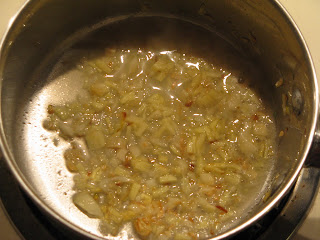
Look, everyone loves pizza. I've been making them at home for a quite a few years now on a pizza stone in the oven, but have fallen in love with making them on the grill a little more recently. Pizzas can be cooked directly on the grill grates, but the higher temperature can lead to burned spots in places or dough that is not cooked all the way through depending on the type of dough you use.
We recently got a
ZaGrill Pizza Cooker from Eastman Outdoors; this ingenious little product has a double heat shield in the base to keep temperatures more consistent on the bottom of the crust. The nonstick cooking pan is removable, which makes taking the pizza on or off the grill a snap. It won a
Vesta award in 2005 for it

s design as well.
First we get the coals ready to maintain a temperature around 450 degrees, spread out evenly over the charcoal grate. Once we're in the correct range, the ZaGrill base is put on the grates to get up to temperature.
My girlfriend Sarah is an artist at rolling out pizza dough in a round shape of uniform thickness, so while I was outside playing caveman she was inside getting the dough ready. We used Trader Joe's refrigerated pizza dough for this pizza, rather than making our own; this dough is very consistent and we've used it quit

e a few times in the past, so we knew what to expect. At less than a buck for a bag of dough, the price and quality are hard to beat. They also make a garlic/herb version as well as whole wheat if you'd like something a little different. Flour was spread across the butcher block to keep the dough from sticking and rolled out into a 12" circle to fit on the cooking pan.
It is important to poke several air holes in the center section of the dough to keep it from puffing up and making a dough-dome when it starts to bake. We also brush a light coating of olive oil on the outer rim of the crust with basting brush. Then we liberally sprinkle on basil flakes and ground italian seasoning, as well as a layer of fresh romano cheese. I'm not a huge fan of most pizza crusts, but I've never left a scrap of one after we've made it this way.



Place the pizza on the cooking pan and onto the ZaGrill base in the grill with your temp around 450 degrees. Put the lid on and cook until the outer crust begins to brown slightly, but not to the point of the center section looking cooked; this usually takes about 5-7 minutes. Remove the entire pan from the grill and place on a clean heat safe surface, keeping in mind that the crust is exposed below the pan slightly through the air holes.
Now that you don't have to worry about the crust moving around on you, add your toppings. We used Trader Joe's pizza sauce for this as well, since we were already there buying dough; its a little on the bland side, so we added more seasonings to it after spreading it on the crust with a smooth bottomed 1 cup measuring cup.


Next we added the cheese and toppings; we went with grated low moisture mozzarella, provolone, parmesan and asiago with sliced pepperoni and green peppers. We like to layer the c

heese in with the toppings, so it all sticks together and the flavors mix together while the pizza cooks. The instructions included with the pizza cooker tell you to cook it at 475 degrees for 25 minutes, but the initial test I did like that ended up with scorched cheese and an over crisped crust, so we went with less time and temperature this time around.

After about 15 minutes at 450 degrees, we started checking the pizza every two minutes or so. The smell was phenomenal, and the hardwood charcoal we used added a little bit of aroma and flavor you wouldn't get from cooking with an indoor oven.
The pizza came off the grill at right around the 20 minute mark and was given a few minutes of rest on a pizza stone (didn't want to use a wheel cutter on the nonstick surface) before cutting into it. Its life was very short after it was sectioned into slices. The crust was just about perfect, slightly crispy without being burned; a lot more evenly browned than I expected it to be. The flavors of the toppings got along with each other very well as would be expected, and the 5 different cheeses added an interesting depth of flavor. The crust was amazing with the added herbs and sharp taste of the romano; if you haven't tried this on homemade pizza you might want to give it a shot. Even the Philly pizza fanatics over at
Pizza is Delicious would approve.

The ZaGrill Pizza Cooker is useful for cooking refrigerated and frozen pre-made pizzas as well as rolled dough of any type. The included instructions are most likely for the frozen variety due to the higher heat and longer duration it would take to bring these up to temperature, although it isn't noted. It is also important to mention that at the low cost of $19.95 shipped on
Amazon.com, you could easily use a couple simultaneously if you had a large enough grill to accommodate them.
The removable pan is also useful for grilling vegetables or smaller items that would normally fall through the grates, but don't tell Nick you used it for that.
Eastman Outdoors also specializes in tons of outdoor grilling and frying equipment, you might want to check out their entire product range; its all top quality stuff.
Look for more grilled pizza recipes here in the future, we're going to keep this going.




















































